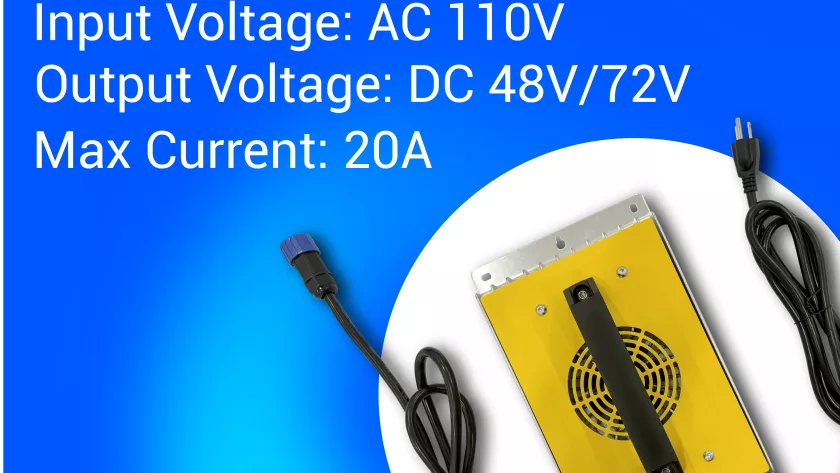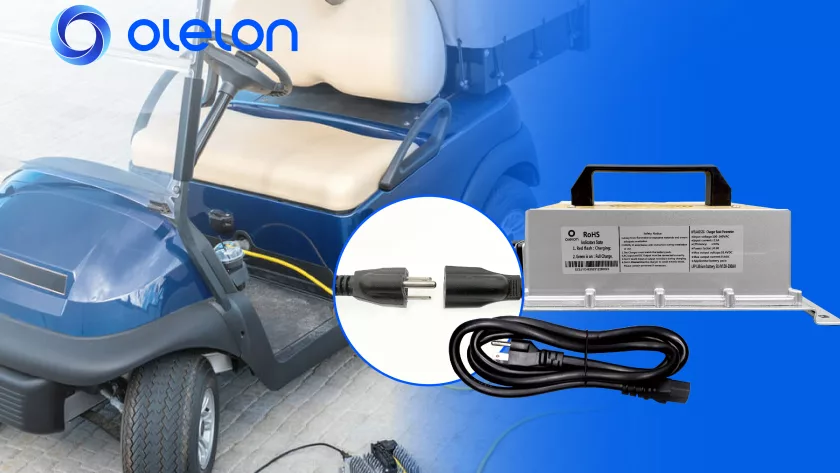Owning an electric golf cart is an efficient and environmentally friendly way to get around, whether on the course, around your neighborhood, or at your worksite. However, maintaining your golf cart’s batteries can be a challenge if you’re not familiar with the charging process. This article may help you gain a deeper understanding of the Golf cart charging tips, charging mistakes to avoid, golf cart battery maintenance, and related topics.
How to Properly Charge Your Golf Cart
Proper charging is essential to extend the life of your golf cart batteries. Here are some general tips:
- Always use the correct charger for your battery type (lead-acid or lithium).
- Charge your golf cart in a well-ventilated area to prevent overheating.
- Avoid overcharging by using an automatic shut-off charger.
- Plug in your golf cart after each use to maintain battery health.
- Ensure battery terminals are clean and free of corrosion.

How Long Does It Take to Charge a Golf Cart?
Charging time depends on the battery type and voltage:
- Lead-Acid Batteries: Typically take 6-8 hours for a full charge.
- Lithium (LiFePO4) Batteries: Charge faster, usually in 3-5 hours.
- Battery Voltage Impact:
- 36V carts: Usually charge within 6-8 hours.
- 48V carts: Take around 4-6 hours.
- 72V carts: Typically charge in 3-5 hours.
How to Charge a 48V Golf Cart
Charging a 48V golf cart is straightforward:
- Connect the charger to the charging port.
- Ensure the charger is compatible with 48V systems.
- Allow the battery to charge fully before disconnecting.
- Use a smart charger to prevent overcharging.
- Regularly inspect cables and terminals for wear.

How to Charge a 48V Golf Cart with a 12V Charger
Using a 12V charger for a 48V system is not recommended, but in an emergency:
- Charge each 12V battery individually (if using lead-acid batteries in a series setup).
- Disconnect batteries from the system before charging one at a time.
- Ensure proper connections to avoid overloading.
- This method is time-consuming and should only be temporary.
How Long Do Golf Cart Batteries Last on One Charge?
The driving range per charge depends on battery type and usage:
- Lead-acid batteries: 15-25 miles per charge.
- Lithium (LiFePO4) batteries: 30-50 miles per charge.
- Terrain, weight, and speed also impact battery range.
How to Test a Golf Cart Battery Charge
To check battery charge:
- Use a voltmeter: Fully charged voltages for different systems:
- 36V cart: ~38.2V
- 48V cart: ~51.2V
- 72V cart: ~76.8V
- Use a hydrometer for lead-acid batteries.
- Check the battery management system (BMS) for lithium batteries.
How to Charge Dead Golf Cart Batteries
If the battery is completely dead:
- Try a manual boost using a 12V automotive charger (for lead-acid batteries).
- Check for corroded terminals and clean them.
- Allow batteries to charge slowly if they are deeply discharged.
- If using lithium batteries, ensure the BMS is reset.
- In extreme cases, consult a professional to revive the battery safely.
How to Charge a Golf Cart Without a Charger
If your charger is unavailable:
- Use a compatible automotive charger (only for lead-acid batteries, charging 12V sections separately).
- Jumpstart using another golf cart (for lead-acid setups).
- Consider solar panels or power inverters for temporary charging.
Best 48V Golf Cart Battery Chargers
Recommended chargers include:
- Lithium-Compatible Chargers: Ensure they have a BMS communication system.
- Smart Chargers: With automatic shutoff to prevent overcharging.
- Fast Chargers: Reduce charging time without harming battery lifespan.
- Waterproof Chargers: Ideal for outdoor storage conditions.
Tips for Maximizing Battery Life
- Use a dedicated charger suited for your battery type.
- Avoid deep discharges—recharge when at 30-50% capacity.
- Store batteries properly: Keep them charged during storage periods.
- Check water levels in lead-acid batteries regularly.
- Keep connections clean and free from corrosion.
- Upgrade to lithium (LiFePO4) batteries for longer lifespan and faster charging.
By following these guidelines, you can ensure your golf cart battery remains in optimal condition for extended performance and longevity.
Related QA:
Q1: What are the best tips for charging a golf cart battery?
A1: To properly charge your golf cart battery:
Charge Regularly: Always charge the battery after use to prevent deep discharge.
Use the Right Charger: Make sure to use a charger designed for your golf cart’s specific battery type (e.g., lead-acid or lithium-ion).
Charge Fully: Aim to charge the battery to full capacity, but avoid overcharging, which can damage the battery.
Charge in a Well-Ventilated Area: Batteries release gases during charging, so ensure proper ventilation.
Avoid Charging Immediately After Use: Allow the batteries to cool down for 30 minutes to an hour before charging to prevent overheating.
Q2: What are some common charging mistakes to avoid?
A2: Common charging mistakes to avoid include:
Overcharging the Battery: Leaving the charger plugged in too long can overcharge and damage the battery. Use a charger with automatic shutoff or a timer.
Not Charging Regularly: Letting the battery sit unused for extended periods without charging can lead to deep discharge and shorten its lifespan.
Charging with Faulty Equipment: Always ensure your charger is working properly. Using old or incompatible chargers can cause damage or poor charging performance.
Charging in Hot Conditions: Avoid charging the battery in extremely hot environments, as high temperatures can damage the battery’s internal components.
Q3: What are the best practices for golf cart battery maintenance?
A3: Effective battery maintenance practices include:
Regular Cleaning: Clean the battery terminals and connections to prevent corrosion. Use a solution of baking soda and water to neutralize any acid buildup.
Monitor Water Levels: For flooded lead-acid batteries, check water levels regularly and refill with distilled water when necessary. Never overfill.
Check for Damage: Periodically inspect the battery for cracks, leaks, or signs of wear and tear.
Tighten Connections: Ensure the battery terminals are tightly connected, as loose connections can cause performance issues or even damage.
Avoid Deep Discharge: Never let the battery run completely flat. Deep discharges can reduce battery life and capacity over time.
Store Properly: If you’re storing the golf cart for an extended period, remove the batteries (if possible), and store them in a cool, dry place. Charge the batteries periodically to prevent them from discharging completely.


3 Comments
Alan prosser
I just had a 48 volt pak installed by my dealer. Iam a snowbird and leave for 6 months do I leave plugged in or ?
admin
Charge the battery every 3-6 months, as it should not be completely depleted after 6 months.
1. Ensure the battery has around 60% state of charge (SOC) before leaving to reduce self-discharge.
2. Remove the battery from the golf cart or disconnect the wires completely.
3. Store the cart in a warm, indoor location.
4. Protect connection points from dust, water, and other debris to prevent rapid depletion.
5. Charge the battery to 100% before using the cart again.
admin
You can follow us on Facebook to get a quicker response. https://www.facebook.com/olelonenergy/